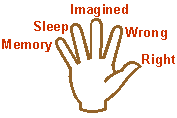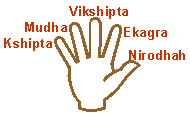Patanjali’s Yoga Sutras – Chapter 1: (Types of Concentration; Sutras 1.17 – 18)
Yoga Sutras 1.17 and 1.18 describe the entire process of samadhi, the higher tool of meditation. Therefore, the whole process of yoga is summarized in these two and the preceding sutras. The remaining yoga sutras give more expanded explanations, including the process of stabilizing the mind and more specific ways to attain samadhi, plus how to learn to use samadhi as the finer tool for Self-realization.

In this diagram “P” indicates with content or object.
Yoga Sutra (1.17) – vitarka vichara ananda asmita rupa anugamat samprajnatah. Vitarka means gross thought or reasoning; Vichara is subtle thought or inquiry; Ananda is even more subtle, bliss; asmita means “I-ness” or sense of self; Rupa is appearance, nature or form; Anagumat means resulting from or associated with; Samprajnatah is absorption, absolute knowledge of, also indicates “lower” Samadhi.
According to this sutra, Samprajnata (lower) Samadhi is explained, defining a deep attention, or concentration on any object. Translated this means…All objects are in one of the four stages listed. Virtually every type, style, method, or object of meditation is assigned to one of the four stages or levels described in this sutra, but here, near the beginning of the yoga sutras specific objects are not being recommended. Instead, the four categories of which any and all possible objects of meditation are introduced. The content itself can be anything; from an external object to an idea in the mind, but as long as there is active content, and the consciousness is absorbed in that content, it is called Samprajnata Samadhi. Sometimes Samprajnata Samadhi is defined as being “with support” or “with seed.”
According to Patanjali, this form of concentration or absorption (with content) consists of four levels. These are:
1: The gross (savitarka): This is the most dense, like an entry level of meditation. It consists of concentration on physical objects (matter), sense perceptions, mental visualizations, streams of thoughts, physical breath, etc.
2. The subtle (savichara): This is a more subtle level of content and concentration. This level consists of attention on the more subtle levels of matter/objects, energies, fundamentals of the mind, and qualities such as non-attachment, etc.
3: Bliss (sananda): This is an even more subtle level of reality and concentration. It consists of attention that goes beyond the gross and subtle levels of the mind. In this state bliss accompanies the meditator.
4: I-ness (sasmita): This level is one of the subtlest states of concentration as its attention is focused on the very core of the individual, the I behind or the witness of all experiences.
*Note on the prefix “sa” in these four words means “with” or accompanied by.
Thus Yoga Sutra (1.17) defines and sums up the whole process (or levels) of the concentration type meditations. The other type of meditation is the seedless (or unsupported) meditation, or meditation without objects or content, which will be defined in the next sutra.
Yoga Sutra (1.17) – virama pratyaya abhyasa purvah samskara shesha anyah. Virama means cessation, letting go, stopping, receding; Pratyaya is the cause, content of mind or cognition; Abhyasa means enthusiastic practice; Purvah indicates preceding or coming before; Samskara means deep impressions, imprints in the unconscious, deep habits, subliminal activators; Shesha is residual or that which remains; Anyah refers to the other (the lower samadhi).
Translated… In this yoga sutra, concentration or attention is without any content or object that can be described, and this is called Asamprajnata (seedless or unsupported) Samadhi. In this state, in addition to the gross and subtle thoughts, the senses and thinking apparatus of the mind remain in a latent state. It is a very high state of “knowing,” and is of the kind that is often described as indescribable in words (beyond words).
Much more than just a state of quietness: It is important to understand that the objectless-ness referred to here is far deeper than simply quieting the busy conscious mind. Allowing that noisy mind to gradually still itself is no doubt an important step, however, it is only a stepping stone to opening the veil obscuring the unconscious. Once attained, the many impressions (samskaras) that are normally not seen are allowed to come forward, and along with them an awareness of the sensing and thinking instruments, the subtle energies, and all the subtle building blocks of mind and matter. All of these, not just the surface level thoughts, are the subject of objectless-ness or seedless meditation.
*Part 1 can be viewed by clicking on: The Teachings of Yoga (Part 1 – Yoga Defined)
*Part 2, here: The Teachings of Yoga (Part 2: Un-coloring Your Thoughts)
*Part 3, here: The Teachings of Yoga (Part 3: Un-coloring Your Thoughts – Cont.)
*Part 4, here: The Teachings of Yoga (Part 4: Practice & Non-Attachment)
*Part 5, here: The Teachings of Yoga (Part 5: Practice & Non-Attachment, cont.)
*Rae Indigo is ERYT500.


 Practice (abhyasa) and non-attachment (vairagya) are the two foundational principles on which the entire system of Yoga rests. Through the cultivation of these two principles, all other Yoga practices evolve and eventually mastery over the mind field (chitta) occurs, and allows the realization of the true Self (Atman).
Practice (abhyasa) and non-attachment (vairagya) are the two foundational principles on which the entire system of Yoga rests. Through the cultivation of these two principles, all other Yoga practices evolve and eventually mastery over the mind field (chitta) occurs, and allows the realization of the true Self (Atman).
